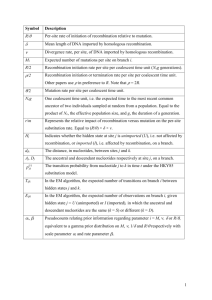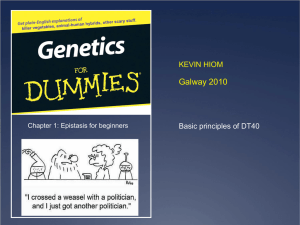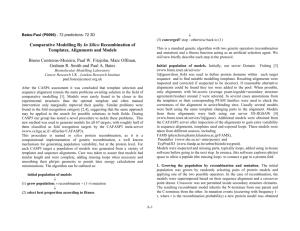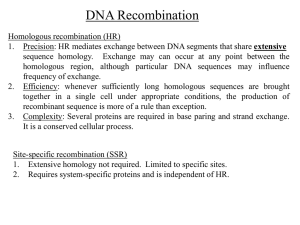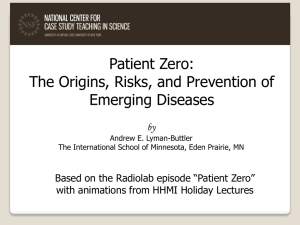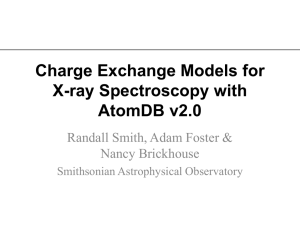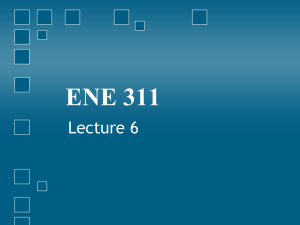Estimating Recombination Rates
advertisement
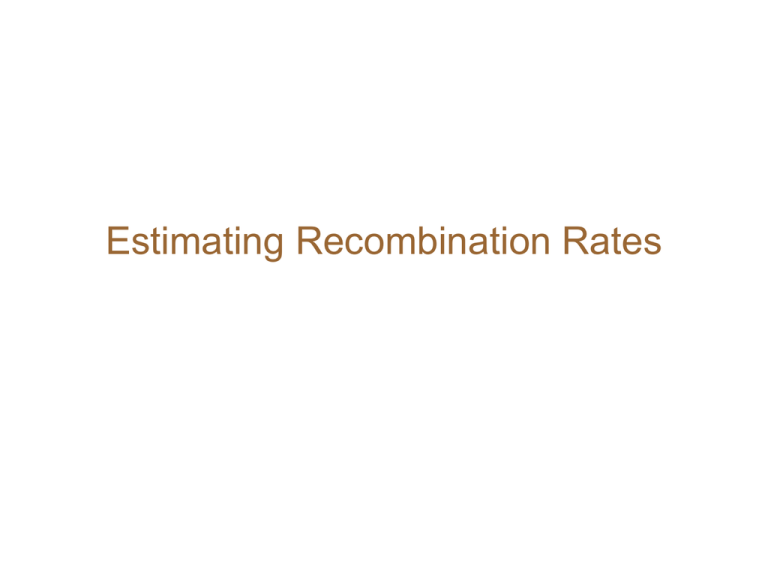
Estimating Recombination Rates
LRH selection test, and recombination
• Recall that LRH/EHH tests for selection by
looking at frequencies of specific haplotypes.
• Clearly the test is dependent on the
recombination rate.
• Higher recombination rate destroys
homozygosity
• It turns out that recombination rates do vary a
lot in the genome, and there are many
regions with little or no recombination
Daly et al., 2001
• Daly and others were looking at a 500kb
region in 5q31 (Crohn disease region)
• 103 SNPs were genotyped in 129 trios.
• The direct approach is to do a case-control
analysis using individual SNPs.
• Instead, they decided to focus on haplotypes
to corect for local correlation.
• The study finds that large blocks (upto 100kb)
show no evidence of recombination, and
contain only 2-4 haplotypes
• There is some recombination across blocks
Daly et al, 2001
Recombination in human chromosome 22
(Mb scale)
Dawson et al.
Nature 2002
Q: Can we give a direct count of the number of the recombination
events?
Recombination hot-spots (fine scale)
Recombination rates (chimp/human)
• Fine scale recombination rates differ between
chimp and human
• The six hot-spots seen in human are not seen in
chimp
Estimating recombination rate
• Given population data, can you predict
the scaled recombination rate in a
small region?
• Can you predict fine scale variation in
recombination rates (across 2-3kb)?
Combinatorial Bounds for estimating
recombination rate
• Recall that expected #recombinations = log n
• Procedure
• Generate N random ARGs that results in the given sample
• Compute mean of the number of recombinations
• Alternatively, generate a summary statistic s from the
population.
• For each , generate many populations, and compute the mean
and variance of s (This only needs to be done once).
• Use this to select the most likely
• What is the correct summary statistic?
• Today, we talk about the min. number of recombination events
as a possible summary statistic. It is not the most natural, but it
is the most interesting computationally.
The Infinite Sites Assumption & the 4 gamete
condition
00000000
3
00100000
5
8
00100001
•
•
00101000
Consider a history without recombination. No pair of sites
shows all four gametes 00,01,10,11.
A pair of sites with all 4 gametes implies a recombination
event
Hudson & Kaplan
• Any pair of sites (i,j) containing 4 gametes must admit a
recombination event.
• Disjoint (non-overlapping) sites must contain distinct
recombination events, which can be summed! This gives a
lower bound on the number of recombination events.
• Based on simulations, this bound is not tight.
Myers and Griffiths’03: Idea 1
• Let B(i,j) be a lower bound on the number of
recombinations between sites i and j.
Define Partition P = 1 = i1 < i2 <
< ik = n
1=i1 i2 i3 i4 i5 i6
R(P)
k1
j1
ik=n
B(i j ,i j 1) is a lower bound for all P!
• Can we compute maxP R(P) efficiently?
The Rm bound
Let Rm ( j) maxPj R(Pj ), for all
partitions of the first j columns
Computing
Rm ( j) for all j is sufficient (why?)
for j 2 n
Rm ( j) max1k j Rm (k) B(k, j)
Improved lower bounds
• The Rm bound also gives a
general technique for
combining local lower bounds
into an overall lower bound.
• In the example, Rm=2, but we
cannot give any ARG with 2
recombination events.
• Can we improve upon Hudson
and Kaplan to get better local
lower bounds?
000
001
010
011
100
101
110
111
Myers & Griffiths: Idea 2
• Consider the history of
individuals. Let Ht denote
the number of distinct
haplotypes at time t
• One of three things might
happen at time t:
– Mutation: Ht increase
by at most 1
– Recombination: Ht
increase by at most 1
– Coalescence: Ht does
not increase
The RH bound
H Number of extant & distinct haplotypes
E Number of mutation events
R Number of Recombination events
H R E 1
R H E 1
Infinite sites E S
R H S 1
Ex: R>= 8-3-1=4
000
001
010
011
100
101
110
111
RH bound
•
•
In general, RH can be quite
weak:
– consider the case when
S>H
However, it can be
improved
– Partitioning idea: sum
RH over disjoint
intervals
– Apply to any subset of
columns. Ex: Apply RH
to the yellow columns
000000000000000
000000000000001
000000010000000
000000010000001
100000000000000
100000000000001
100000010000000
111111111111111
Caveat : Computing max H' H R(H') is NP - complete!
(BB’05)
Computing the RH bound
• Goal: Compute
– Max H’ R(H’)
• It is equivalent to the
following:
• Find the smallest subset of
columns such that every pair
of rows is ‘distinguished’ by
at least one column
• For example, if we choose
columns 1, 8, rows 1,2, and
rows 5,6 remain identical.
• If choose columns 1,8,15 all
rows are distinct.
123456789012345
1:000000000000000
2:000000000000001
3:000000010000000
4:000000010000001
5:100000000000000
6:100000000000001
7:100000010000000
8:111111111111111
(BB’05)
Computing RH
• A greedy heuristic:
–
–
–
–
Remove all redundant rows.
Set of columns, C=Ø
Set S = {all pairs of rows}
Iterate while (S<>Ø):
• Select a column c that separates maximum number of
pairs P in S.
• C=C+{c}
• S=S-P
– Return n-1-|C|
Computing RH
• How tight is RH?
• Clearly, by removing
a haplotype, RH
decreases.
• However, the number
of recombinations
needed doesn’t really
change
000
001
010
011
100
101
110
111
Rs bound: Observation I
s
Non-informative column: If a
site contains at most one 1, or
one 0, then in any history, it
can be obtained by adding a
mutation to a branch.
EX: if a is the haplotype
containing a 1, It can simply be
added to the branch without
increasing number of
recombination events
R(M) = R(M-{s})
0
0
0
:
:
1
a
a b
c
Rs bound: Observation 2
• Redundant rows:
If two rows h1
and h2 are
identical, then
– R(M) = R(M-{h1})
r1
r2
c
Rs bound: Observation 3
• Suppose M has no noninformative columns, or
redundant rows.
– Then, at least one of the
haplotypes is a recombinant.
– There exists h s.t.
R(M) = R(M-{h})+1
– Which h should you choose?
Rs bound (Procedural)
Procedure Compute_Rs(M)
If non-informative column s
return (Compute_Rs(M-{s}))
Else if redundant row h
return (Compute_Rs(M-{h}))
Else
return (1 + minh(Compute_Rs(M-{h}))
Results
Additional results/problems
• Using dynamic programming, Rs can be computed in
2^n poly(mn) time.
• Also, Rs can be augmented to handle intermediates.
• Are there poly. time lower bounds?
– The number of connected components in the conflict graph is a
lower bound (BB’04).
• Fast algorithms for computing ARGs with minimum
recombination.
– Poly. Time to get ARG with 0 recombination
– Poly. Time to get ARGs that are galled trees
(Gusfield’03)
Underperforming lower bounds
• Sometimes, Rs can be quite weak
• An RI lower bound that uses intermediates can help
(BB’05)
LPL data set
• 71 individuals, 9.7Kbp genomic sequence
– Rm=22, Rh=70
